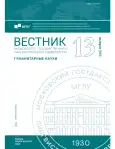THE ISSUE OF FORMATTING MULTIPLE IDENTITIES AMONG SPORTS LEGIONNAIRES
- Authors: Averina M.V.1
-
Affiliations:
- Moscow State Linguistic University
- Issue: No 13(894) (2024)
- Pages: 148-153
- Section: Cultural studies
- URL: https://journal-vniispk.ru/2542-2197/article/view/291638
- ID: 291638
Cite item
Full Text
Abstract
In today’s global society, migration processes have reached enormous proportions. Some migrants, due to various reasons, relocating from their countries of origin to recipient countries or moving between multiple countries, are referred to as transmigrants. This group rightfully includes sports legionnaires (foreign players) who sign contracts with sports clubs in different countries while remaining citizens of their home states and members of their national teams. This article analyzes the formation of multiple identity within this group, clarifies the components of the multiple identity they develop. The main purpose of this study is to identify the positive and negative contributions this group makes to the civilizational development of sports.
About the authors
Marina Vladimirovna Averina
Moscow State Linguistic University
Author for correspondence.
Email: m-averina@list.ru
Doctor of Cultural Anthropology, Associate Professor, Professor of Department of communication technology
Institute of International Relations and Social and Political Sciences, Moscow State Linguistic University
References
- Giddens, A. (1991). Modernity and self-identity: self and society in the late modern age. Stanford: Stanford University Press.
- Hantington, S. (2004) Kto my`? Vy`zovy` amerikanskoj nacional`noj identichnosti. = Who are we? Challenges of American national identity. Moscow: TransitBook. (In Russ.)
- Horenczyk, G., Jasinskaja-Lahti, I., Sam, D. L., Vedder, P. (2013). Mutuality in acculturation // Psychol., 221(4), 205–213.
- Castells, M. (2015). Networks of outrage and hope: social movements in the internet age. New York: Wiley.
- Doucerain, M. M. (2018) Heritage acculturation is associated with contextual factors at four different levels of proximity. Cross Cult Psychol., 49(10), 1539–1555.
- Ward, C., Ng Tseung-Wong, C., Szabo, A., Qumseya, T., Bhowon, U. (2018). Hybrid and alternating identity styles as strategies for managing multicultural identities // J Cross Cult Psychol., 49(9), 1402–1439.
- Melonashi, E. (2017). Social media and identity. In Anabela, M. (Ed.), Research paradigms and contemporary perspectives on human-technology interaction (p. 6283). Hershey: IGI Global.
- Sana, R., Deborah, V. (2004). Guide to Cross-Cultural Communication. Upper Saddle River, N.J. Prentice Hall.
- Volkov, Yu. G., Kurbatov, V. I. (2022). Hybrid identity: factors of formation and forms of manifestation. The Humanities of the South of Russia, 11(54)-2, 15–25. (In Russ.)
- Brubaker, R., Cooper, F. (2000). Beyond «identity». Theory Soc., 29, 1–47. 10.1023/A:1007068714468.
- Ward, T. (2009). Sport and national identity. Soccer Soc., 10, 518–531. 10.1080/14660970902955455.
- Hall, S. (1980). Encoding and Decoding. Culture, Media, Language (pp. 128–139). London: Hutchinson.
- Habermas, Yu. (2001). Moral consciousness and communicative action. St. Petersburg: The science. (In Russ.)
- Seiberth, K., Thiel, A., John, J. M. (2022). «It’s My Country I’m Playing for» – A Biographical Study on National Identity Development of Youth Elite Football Players with Migrant Background. Front. Sports Act. Living, 4, 893019.
Supplementary files










